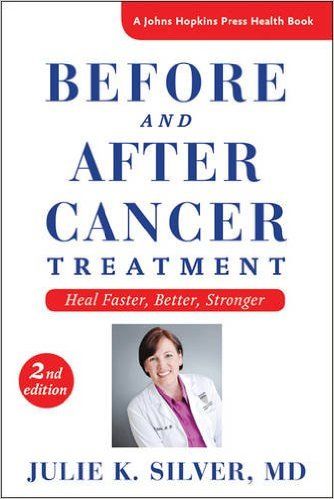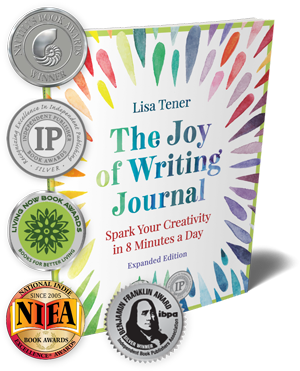 Julie Silver, MD is director of Harvard Medical School’s CME course on Healthcare Leadership and Publishing. I have interviewed her before on how to write a health book and earlier this year on publishing trends and tips. With the second edition of Before and After Cancer Treatment just out–and people all over celebrating breast cancer awareness, it seemed a perfect time to bring Dr. Silver back to answer questions about when and why to write a second edition, how to write a second edition, specific challenges authors face in updating to a new edition and also specifics of what readers will get out of this important book.
Julie Silver, MD is director of Harvard Medical School’s CME course on Healthcare Leadership and Publishing. I have interviewed her before on how to write a health book and earlier this year on publishing trends and tips. With the second edition of Before and After Cancer Treatment just out–and people all over celebrating breast cancer awareness, it seemed a perfect time to bring Dr. Silver back to answer questions about when and why to write a second edition, how to write a second edition, specific challenges authors face in updating to a new edition and also specifics of what readers will get out of this important book.
Lisa: I’d like to start with the idea of a second edition: Why is a second edition of a book needed? When is it necessary? I imagine that with a book like Before and After Cancer Treatment new treatment methods come up, new research—so that at least some of the information is eventually out of date. Is that the main reason Johns Hopkins University Press published a second edition? Were there other reasons?
Dr. Silver: The second edition of Before and After Cancer Treatment has a lot of new updates that are due to medical advances that support survivors’ recovery. For example, the concept of “prehabilitation” is introduced for the first time in this new edition, and I explain how it is different from “patient education.” Prehabilitation involves actual interventions that improve outcomes for survivors—it helps to empower them and focuses on things that will make a difference in their physical and emotional health. The first edition was called After Cancer Treatment, and for this new edition we added “Before and” to the title to emphasize that this is a book for people who are newly diagnosed as well as those currently going through therapy or finished with treatment.
Lisa: Had you gotten reader feedback that inspired any new features or content? Things that readers had requested or questions they’d asked that spurred new material?
 Dr. Silver: The excellent Amazon reviews for this book, and the number of hospitals that ordered bulk copies to give to every newly diagnosed patient has made this book such a worthwhile endeavor.
Dr. Silver: The excellent Amazon reviews for this book, and the number of hospitals that ordered bulk copies to give to every newly diagnosed patient has made this book such a worthwhile endeavor.
Lisa: Once you decide to write a second edition, what’s the process of updating the book? What steps do you take and how long did it take?
Dr. Silver: It took about 6 months to do the actual research and writing and then another 6 months for editing and getting to the finished book.
Lisa: [bctt tweet=”What are the pitfalls to watch out for in writing a second edition?”]
Dr. Silver: I was tempted to rewrite more than I needed to. I had to remind myself that the first edition really resonated with and helped survivors. I wanted to be sure that I didn’t change it too much and lose that strong connection with the readers.
Lisa: Great point. Was writing the second edition much quicker than writing a book from scratch or not?
Dr. Silver: Yes, it is definitely faster and easier! As long as you focus on an update and don’t try to rewrite the whole thing.
Lisa: You share some personal details that you reveal are very hard to admit—for instance how hard it was to care for your children at some points, that you just “sat around” at some points during your treatment. Was it a process to decide what to reveal and to feel safe enough to do so? Any tips for authors on how to do that?
Dr. Silver: Yes, that part was and is definitely hard. It’s important to let readers understand your story, but at the same time, I wanted them to focus more on the medicine than on me. So, striking that balance was something I spent a lot of time on.
Lisa: That’s great advice for any self-help author—to consider how much of their story to provide depth and context and how much to leave out, as well. In Before and After Cancer Treatment you share the story of when and why you decided to write this book. It’s a great example of there being books on the subject but that you had something unique to offer that wasn’t out there in the marketplace, in particular, you and your colleagues developed a model for cancer rehabilitation care that you call “STAR” – Cancer Survivorship, Training and Rehabilitation, and developed programs so that institutions could adopt this model which helps maximize long-term survival and prevention of recurrence. When did this idea come about? Did it happen as you were writing the book?
Dr. Silver: A few years after the first edition came out, I developed the STAR Program which is a turnkey solution for hospitals and cancer centers to offer survivors rehabilitation services. Cancer rehabilitation medical care is generally covered by health insurance, but too few survivors get these important services. This means that they live with more pain, fatigue, weakness and disability than is necessary. There is a lot of suffering in cancer, but there’s no need to have unnecessary suffering when cancer rehabilitation can help. Survivors can find a STAR Program near them by putting their zip code into the STAR Program finder on the STAR Program website. If there isn’t a STAR Program near them, they should ask their doctors if they know about it. Many new hospitals are adopting it every week!
Lisa: What are some of the things you are doing to spread the word about Before and After Cancer Treatment?
Dr. Silver: There are quite a few people like you who believe in my work and are willing to share it with survivors. It’s a privilege to be able to help people when they are sick.
Lisa: What would you like to leave our readers with?
Dr. Silver: No book can replace excellent medical care—I want people to read Before and After Cancer Treatment, but I also want them to ask their doctors about cancer rehabilitation medical care and to find a STAR Program near them.
Ask your questions about the book, writing or publishing–our favorite question or comment wins a free copy of Dr. Silver’s book!



I am the publisher of a book of essays on fatherhood by different contributors. I am working on a new book with new essays on fatherhood with some of the same contributors from the first book. Should I label the second book as Second Edition? The title will be the same for each book.
So, if many of the essays are the same, you could call this a second edition. Note that it would need its own ISBN number. I have more information in this article: “How Much New Material is Needed for a Second Edition of a Book?” Also, here is an author interview with Julie Silver, MD, which discusses when and how to write a second edition of a book.
How do you change the name of a book in the Second Edition?
Good question. I’m going to ask a colleague to answer. Meantime, do know that if you change the title it will need a new ISBN number. This post my be helpful as well.
Great question Helen! As you Lisa pointed out you will need to get a new ISBN and then update your title wherever you have it published such as Amazon. Be careful though – because if you change your title and your ISBN, you may have to delete your current book files (unpublish). Consider this carefully if you have a lot of reviews as these will not carry over to your new file. If you are published on Amazon, you may want to contact them confirm what I am telling you here.
Thank you, Howard. I knew you’d have more in depth knowledge of this than I do.
Reading your response, I also realized that one would need to make sure that readers of the first title don’t accidentally buy the second thinking they are getting a whole new book and then feeling disappointed or misled, so it would be important to make it clear on the cover that this is a second edition of [former Title].